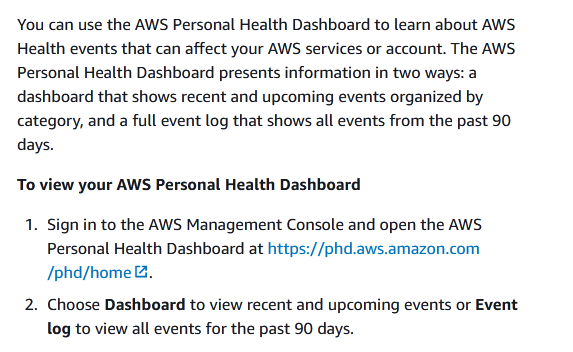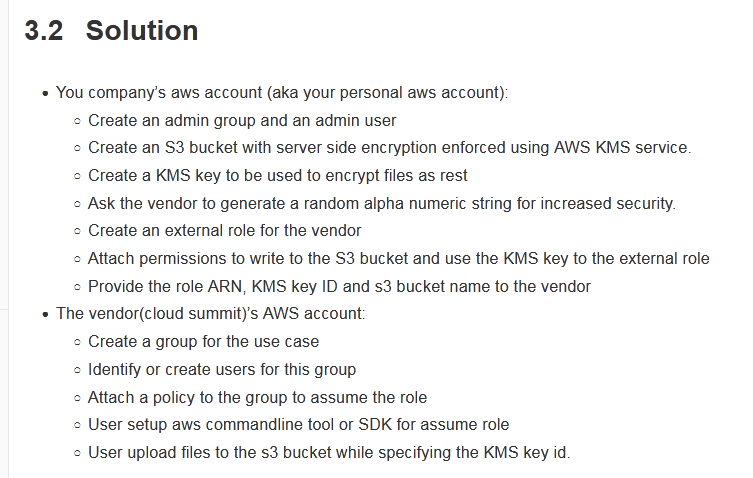A company has a stateful, long-running workload on a single xlarge general purpose Amazon EC2 On-Demand Instance Metrics show that the service is always using 80% of its available memory and 40% of its available CPU. A SysOps administrator must reduce the cost of the service without negatively affecting performance.
Which change in instance type will meet these requirements?
B
A company asks a SysOps administrator to ensure that AWS CloudTrail files are not tampered with after they are created. Currently, the company uses AWS
Identity and Access Management (IAM) to restrict access to specific trails. The company's security team needs the ability to trace the integrity of each file.
What is the MOST operationally efficient solution that meets these requirements?
C
When the AWS Cloud infrastructure experiences an event that may impact an organization, which AWS service can be used to see which of the organization's resources are affected?
C
Reference:
https://docs.aws.amazon.com/health/latest/ug/getting-started-phd.html
A company is using an AWS KMS customer master key (CMK) with imported key material. The company references the CMK by its alias in the Java application to encrypt data. The CMK must be rotated every 6 months.
What is the process to rotate the key?
B
Reference:
https://aws.amazon.com/kms/faqs/
The security team is concerned because the number of AWS Identity and Access Management (IAM) policies being used in the environment is increasing. The team tasked a SysOps administrator to report on the current number of IAM policies in use and the total available IAM policies.
Which AWS service should the administrator use to check how current IAM policy usage compares to current service limits?
A
Reference:
https://docs.aws.amazon.com/awssupport/latest/user/trusted-advisor-check-reference.html#iam-policies
A SysOps administrator is trying to set up an Amazon Route 53 domain name to route traffic to a website hosted on Amazon S3. The domain name of the website is www.example.com and the S3 bucket name DOC-EXAMPLE-BUCKET. After the record set is set up in Route 53, the domain name www.anycompany.com does not seem to work, and the static website is not displayed in the browser.
Which of the following is a cause of this?
D
Reference:
https://aws.amazon.com/premiumsupport/knowledge-center/route-53-no-targets/
A SysOps administrator has used AWS CloudFormation to deploy a serverless application into a production VPC. The application consists of an AWS Lambda function, an Amazon DynamoDB table, and an Amazon API Gateway API. The SysOps administrator must delete the AWS CloudFormation stack without deleting the DynamoDB table.
Which action should the SysOps administrator take before deleting the AWS CloudFormation stack?
A
A SysOps administrator is notified that an Amazon EC2 instance has stopped responding. The AWS Management Console indicates that the system checks are failing.
What should the administrator do first to resolve this issue?
B
A software development company has multiple developers who work on the same product. Each developer must have their own development environments, and these development environments must be identical. Each development environment consists of Amazon EC2 instances and an Amazon RDS DB instance. The development environments should be created only when necessary, and they must be terminated each night to minimize costs.
What is the MOST operationally efficient solution that meets these requirements?
C
A company is partnering with an external vendor to provide data processing services. For this integration, the vendor must host the company's data in an Amazon
S3 bucket in the vendor's AWS account. The vendor is allowing the company to provide an AWS Key Management Service (AWS KMS) key to encrypt the company's data. The vendor has provided an IAM role Amazon Resources Name (ARN) to the company for this integration.
What should a SysOps administrator do to configure this integration?
D
Reference:
https://bookdown.org/bingweiliu11/aws-tutorial-book/use-case.html